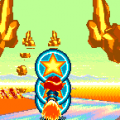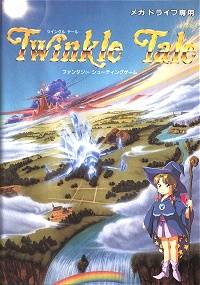
Japanese Mega Drive Cover
Twinkle Tale is an overhead run-and-gun that was released exclusively in Japan for the Mega Drive, and was developed by a very obscure developer called Wonder Amusement Studio. It sets itself apart from other games in its genre due to its unique setting – it combines Mercs-style gameplay with a cutesy witch theme similar to the Cotton series of shoot-em-ups. You spend the entire game plowing through each level and mowing down anything and everything in sight with an assortment of weapons and bombs. Except your character is a witch named Saria, complete with a magic staff and pointy hat, rather than a machine-gun toting commando, and the stages and enemies have a fantasy theme rather than your standard Rambo / Commando inspired settings that are so prevalent in the genre. The enemies themselves are a mix of various generic fantasy monsters and the stages vary from castles, to stone walkways in the sky, to simple grassy fields. The title screen shows a floating island (where this takes place) and the intro screen (which explains the plot) is designed to look like a picture book, which is perfect for the tone of the game.
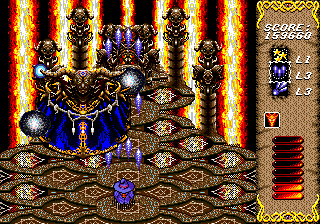
Twinkle Tale (Mega Drive)
First off, Twinkle Tale moves quickly. Saria dashes across the screen pretty quickly, and enemy attacks are equally as fast. Thankfully, you’ve got a full arsenal of attacks always at your disposal. Most run ‘n’ gun games give you a lone standard weapon and a handful of secondary weapons that are dropped by enemies. Comparatively, Twinkle Tale gives you three completely different weapons for the entirety of the game. The C button on the control pad will switch between weapons and the B button will fire your currently selected weapon. The Shooting Star fires a high-powered wide stream directly forward, the Diamond Arrow shoots in multiple directions at once, and the Silver Comet is slightly lower-powered shot with homing capabilities. This gives Twinkle Tales‘s combat much more variation than what you generally find in overhead run ‘n’ guns, which is perhaps the best thing about the game. There is never really any best weapon, but you’ll find that you’ll generally get better results with specific weapons against certain enemies. This mechanic was later used to varying levels of success in Radiant Silvergun and Neo Contra.
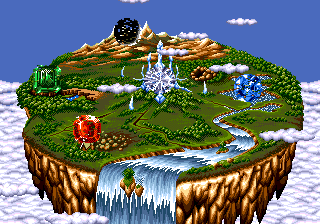
Twinkle Tale (Mega Drive)
Each weapon can be powered-up by finding stars that are stashed away in treasure chests, which will raise you current weapon one level up to a maximum of level three. Conveniently, if your current weapon is at max-level, grabbing one of these will power-up one of your other two attacks. In addition to knocking a notch off your health meter, getting hit also lowers your current weapon’s power level, so it can be wise to switch to the weapon that you need least at certain times. There are two different bombs, again found in treasure chests – a bomb with homing capabilities and a full-screen bomb. Both kinds are activated by pushing the A button.
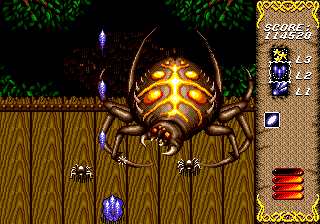
Twinkle Tale (Mega Drive)
There are nine levels in total in Twinkle Tale – each challenging, but fair. However, if you find yourself overwhelmed, you can change the difficulty setting in the options mode, and there’s a handy level select cheat (at the storybook screen that you see shortly after pushing start at the title screen, hold up-left, A, and C, and hit start. Then select your starting level with the directional pad.) The boss fights in particular are pretty cool too. Each level’s boss is fought like in a vertical shoot-em-up, with your character only being able to fire directly upward. Each boss is completely massive, with movement patterns and bullet patterns that immediately bring to mind the kind that you would expect from a shoot-em-up. So shooter fans should dig these segments of the game, and might find it worth their while to play the thing for these sections alone. If the boss fights alone aren’t enough for you, the shoot-em-up elements are taken a step further in level seven, which is played out entirely as a vertical shooter stage.
Twinkle Tale (Mega Drive)
Something else that really stands out about Twinkle Tale is the level of variation in its stages, which consistently involve more than simply moving in the appropriate direction and blowing stuff up. A particularly good example of this fact is level three, where you have to traverse a series of stone walkways in the sky. As opposed to most similar games, where you can walk along the edge of cliffs without worrying about falling off, here if you walk past the edge of any of these walkways, you’ll promptly plummet to the ground and get a Game Over. Elsewhere in this same level is a section where you have to travel across a series of airborne moving platforms, and if your timing is off, you’ll fall to your death. This is similar to some segments in Legend of Valkyrie, the only game that’s even remotely similar. There are other off-limits sections of the terrain elsewhere in the game, like the water in level five.
Twinkle Tale (Mega Drive)
Also, several levels have brief segments where you are forced to dodge obstacles, like falling boulders in the first level, giant steel balls in the second level, or jets of fire later in the game. If these things seem like they would be out of place in a run ‘n’ gun, where you would normally spend your time just blasting away at things, it’s actually all very well applied and never takes more than a few seconds. So it serves to mix things up, rather than bog down its pace, and makes the game even more interesting. Also, while a few levels do technically have branching paths, they are pretty much exactly the same and don’t really differ in any particularly relevant way.
Twinkle Tale (Mega Drive)
Twinkle Tale was made in the middle years of the Genesis’ life span, but it looks like a later release for the console. The graphics, while still grainy compared to a SNES title, are easily among the best on the platform. The graphics are very colorful, the sprites are well detailed, and the backgrounds are fantastically designed. The game takes place on a floating island and the sprite artists have exploited that very well in the background designs. Many of the levels show glimpses of the world far below through pillars or windows, and other stages, like level three, make the contrast in distances between the two locations a means of emphasizing the height of the immediate terrain. The interior sections of stages – like the wooden floors and vines growing on the walls in level four, the torch-lit caves of level five, or the icy (or crystal, possibly) walls of level eight – look pretty amazing as well. Level seven is easily the best looking of them all. It takes place among the clouds, and there are several broken-off chunks of castle walls that are kept afloat with propellers. The details on the ground are extremely small to emphasize that it’s set even higher above the ground than the other levels. The designs for each stage’s final boss are especially nice looking. The final boss of the game is a guy sitting in a throne who eventually becomes a giant elaborately detailed monster. After beating him, you get a brief ending and then an awesome highly detailed sprite art image of a backward magic book. Twinkle Tale‘s music is pretty nice as well. Its whimsical level themes and constant explosions all come through the limited hardware pretty well.
Twinkle Tale (Mega Drive)
Generally, any game with a cutesy anime girl shooting crap is pretty much guaranteed a huge cult following. Twinkle Tale is something of an exception to this, and probably didn’t do too well back in its day either. It hasn’t been ported, sequeled, spiritually sequeled, or anything other than largely ignored (although it has been fan translated.) For whatever reason, it was supposedly pulled from store shelves shortly after its release. As a result, it’s quite rare and can fetch a pretty penny on online auctions. It’s definitely worth checking out though. If you do, you’ll find a hidden gem that’s among the best the genre has to offer, and arguably the best overhead run ‘n’ gun for the console.

